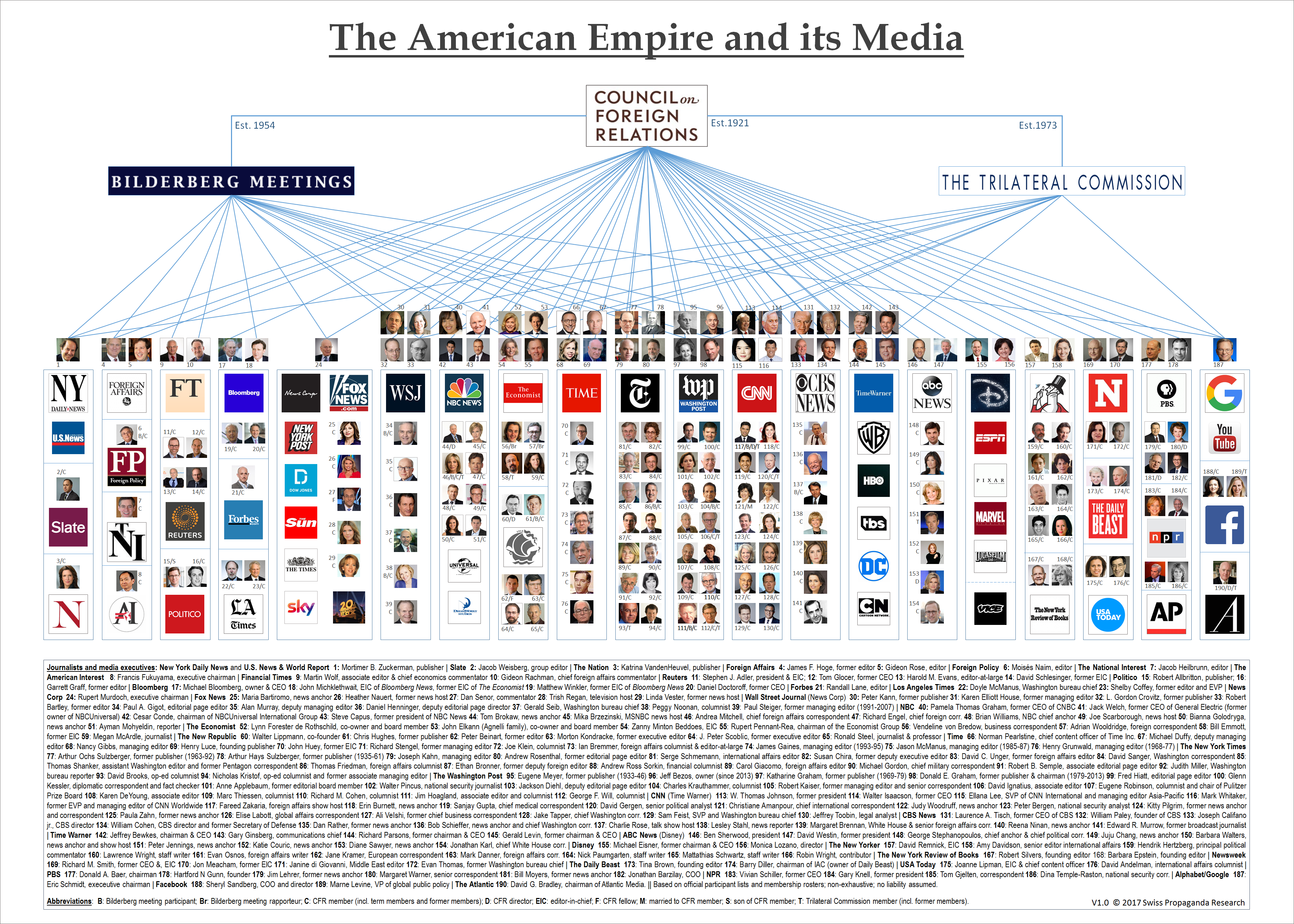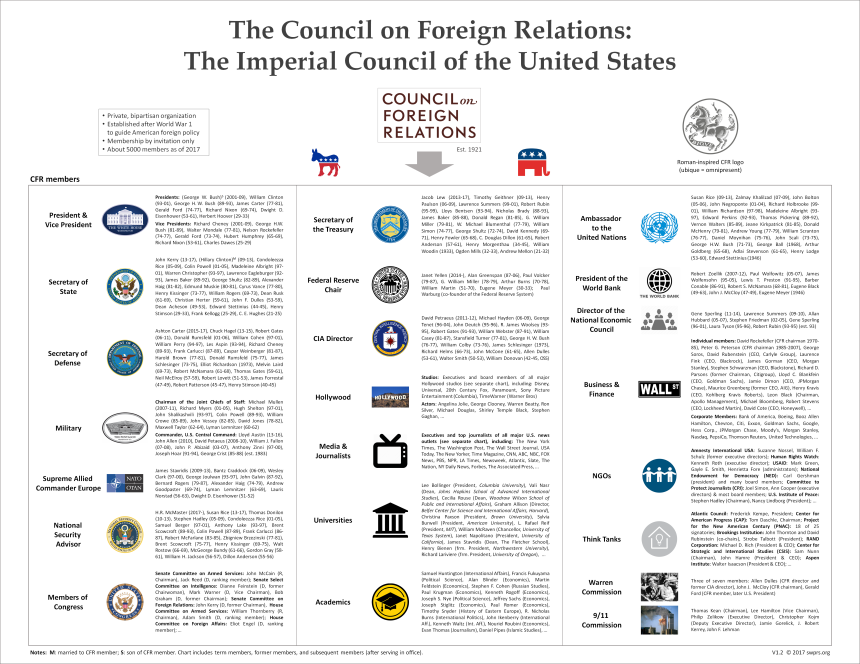L’empire médiatique américain: comment les USA contrôlent le monde – Swiss Policy Research

A l’insu du grand public, les responsables et les grands journalistes de pratiquement toutes les maisons de presse américaines majeures ont, pendant longtemps, fait partie de l’influent Conseil pour les relations internationales (Council on Foreign Relations), écrit le portail Vestifinance.
Fondé en 1921 en tant qu’organisation privée pour «forcer l’Amérique à remplir ses engagements internationaux», le Conseil pour les relations internationales (CFR) et ses 5.000 membres élitaires ont influencé pendant des décennies la formulation de la politique étrangère des États-Unis, révèle le portail Vestifinance. Comme l’a déclaré un jour un membre éminent du conseil, le principal objectif consistait à «créer un empire mondial», mais «avec une disposition assez bienveillante».
© AFP 2020 Christian Bruna
Vestifinance publie donc les infos dévoilant le vaste réseau médiatique du CFR, sur la base des listes officielles d’adhésion reprises dans l’illustration ci-dessous, ainsi que de ses principales organisations de partenariat internationales: le Club Bilderberg (couvrant essentiellement les USA et l’Europe) et la Commission trilatérale (englobant l’Amérique du Nord, l’Europe et l’Asie orientale) créés par les dirigeants du CFR pour développer la coopération élitaire au niveau international.
Dans un billet, l’ancien rédacteur en chef du Washington Post et ombudsman Richard Harwood approuve le conseil et ses membres: «La participation de ces journalistes au conseil est la reconnaissance de leur rôle actif et important dans les affaires publiques et de leur présence dans la classe dirigeante américaine. Ils n’analysent pas et n’interprètent pas simplement la politique étrangère des USA: ils la forment. Ils font partie de cet establishment, que cela leur plaise ou non, partagent une grande partie de ses valeurs et de sa vision du monde.»
Cependant, les leaders des médias ne représentent que 5% du réseau global du CFR. Comme l’indique Vestifinance, les principaux membres du Conseil privé pour les relations internationales étaient:
— plusieurs Présidents des USA et vice-présidents des deux bords;
— pratiquement tous les secrétaires d’État, ministres de la Défense et des Finances;
— plusieurs hauts commandants des forces armées des USA et de l’Otan;
— pratiquement tous les conseillers à la sécurité nationale, les directeurs de la CIA, les ambassadeurs à l’Onu, les présidents de la Réserve fédérale (Fed), les présidents de la Banque mondiale et les directeurs du Conseil économique national (National Economic Council);
— certains membres du Congrès très influents (notamment en matière de politique étrangère et de sécurité);
— plusieurs juges suprêmes, dirigeants des médias et responsables de l’industrie du divertissement;
— plusieurs scientifiques éminents, notamment dans les domaines-clés comme l’économie, les relations internationales, la politologie, l’histoire et le journalisme, plusieurs responsables de Wall Street, de centres analytiques, d’universités et d’ONG;
— les principaux membres de la commission 9/11 et de la commission Warren.
Le célèbre économiste et partisan de Kennedy, John Galbraith, a confirmé l’influence du conseil: «Il y avait une bonne attitude au gouvernement envers tous ceux parmi nous qui travaillaient pour l’élection de Kennedy, cependant la politique étrangère continuait de dépendre des hommes du Council on Foreign Relations.»
John McCloy, ancien président du conseil et conseiller de 9 présidents des États-Unis évoquait en ces termes son séjour à Washington: «A chaque fois que nous avions besoin d’un homme, nous regardions la liste des membres du conseil et téléphonions à New York.»
Le journal allemand Der Spiegel a décrit un jour le CFR comme «l’établissement privé le plus influent des USA et du monde occidental» et «le politburo du capitalisme». Le logotype du conseil et son slogan ne font que souligner ces ambitions.
Le commentateur politique Richard Rover avait noté à une époque: «Les dirigeants du CFR représentent une sorte de présidium de la partie de l’establishment qui décide de notre sort en tant que nation. Il est rare de ne pas rencontrer un membre ou du moins un de leurs alliés à la Maison Blanche.»
Jusqu’à récemment, cette perception était effectivement justifiée. Ainsi, en 1993, l’ancien chef du CFR George H. W. Bush a été suivi par le membre du CFR Bill Clinton, suivi à son tour par le membre du clan CFR George W. Bush.
En 2008, le membre du CFR John McCain s’est incliné dans la course présidentielle face au candidat du CFR Barack Obama, qui avait reçu les noms de l’ensemble de son cabinet à un mois de son élection de la part du chercheur en chef du CFR (et banquier de Citigroup) Michael Froman. Par la suite, ce dernier avait mené les négociations sur les accords de libre-échange TTP et TTIP avant de revenir au CFR en tant que collaborateur émérite.
Les opinions exprimées dans ce contenu n’engagent que la responsabilité de l’auteur de l’article repris d’un média russe et traduit dans son intégralité en français.
via Vestifinance.ru . Sputnik France
via The American Empire and its Media – Swiss Policy Research
Published: July 2017; Updated: December 2019
Languages: AR, CN, DE, ES, FR, GR, JP, KO, PL, RU, TR
Share on: Twitter / Facebook
Largely unbeknownst to the general public, executives and top journalists of almost all major US media outlets have long been members of the influential Council on Foreign Relations (CFR).
Established in 1921 as a private, bipartisan organization to “awaken America to its worldwide responsibilities”, the CFR and its close to 5000 elite members for decades have shaped US foreign policy and public discourse about it. As a well-known Council member famously explained, they transformed the American republic into a global empire, albeit a “benevolent” one.
Based on official membership rosters, the following illustration depicts for the first time the extensive media network of the CFR and its two major international affiliate organizations: the Bilderberg Group (mainly covering the US and Europe) and the Trilateral Commission (covering North America, Europe and East Asia), both established by Council leaders to foster elite cooperation at the global level.
In a column entitled “Ruling Class Journalists”, former Washington Post senior editor and ombudsman Richard Harwood described the Council and its members approvingly as “the nearest thing we have to a ruling establishment in the United States”.
Harwood continued: “The membership of these journalists in the Council, however they may think of themselves, is an acknowledgment of their active and important role in public affairs and of their ascension into the American ruling class. They do not merely analyze and interpret foreign policy for the United States; they help make it. () They are part of that establishment whether they like it or not, sharing most of its values and world views.”
However, media personalities constitute only about five percent of the overall CFR network. As the following illustration shows, key members of the private Council on Foreign Relations have included:
- several US Presidents and Vice Presidents of both parties;
- almost all Secretaries of State, Defense, and the Treasury;
- many high-ranking commanders of the US military and NATO;
- some of the most influential Members of Congress (notably in foreign & security policy);
- almost all National Security Advisors, CIA Directors, Ambassadors to the U.N., Chairs of the Federal Reserve, Presidents of the World Bank, and Directors of the National Economic Council;
- many prominent academics, especially in key fields such as Economics and Political Science;
- many top executives of Wall Street, policy think tanks, universities, NGOs, and Hollywood;
- as well as the key members of both the 9/11 Commission and the Warren Commission (JFK)
Harvard economist and Kennedy supporter, John K. Galbraith, confirmed the Council’s influence: “Those of us who had worked for the Kennedy election were tolerated in the government for that reason and had a say, but foreign policy was still with the Council on Foreign Relations people.”
Princeton University professor and former CFR member Stephen F. Cohen described the Council as “America’s single most important non-governmental foreign-policy organization”, whose primary role is to “define the accepted, legitimate, orthodox parameters of discussion.” According to Cohen, “the CFR really is what the Soviets used to call the very top-level of the Nomenklatura.”
And no less than John J. McCloy, the longtime chairman of the Council and advisor to several US presidents, recalled about his time in Washington: “Whenever we needed a man we thumbed through the roll of the Council members and put through a call to New York [i.e., the CFR headquarters].”
 1945 to 2017: CFR members in key positions of the American Empire
1945 to 2017: CFR members in key positions of the American Empire
Click to enlarge 🔎
German news magazine Der Spiegel once described the CFR as the “most influential private institution of the United States and the Western world” and a “politburo of capitalism”. Both the Roman-inspired logo of the Council (top right in the illustration above), as well as its slogan (ubique – omnipresent), appear to emphasize this ambition.
In his famous article about “The American Establishment”, political columnist Richard H. Rovere noted: “The directors of the CFR make up a sort of Presidium for that part of the Establishment that guides our destiny as a nation. () [I]t rarely fails to get one of its members, or at least one of its allies, into the White House. In fact, it generally is able to see to it that both nominees are men acceptable to it.”
Until recently, this assessment indeed was justified. Thus, in 1993 former CFR director George H.W. Bush was followed by CFR member Bill Clinton, who in turn was followed by CFR “family member” George W. Bush. In 2008, CFR member John McCain lost against CFR candidate of choice, Barack Obama, who received the names of his entire Cabinet already one month prior to his election by CFR Senior Fellow (and Citigroup banker) Michael Froman. Froman later negotiated the TPP and TTIP trade agreements, before returning to the CFR as a Distinguished Fellow.
It was not until the 2016 election that the Council couldn’t, apparently, prevail. At any rate, not yet.
∗∗∗
Update 2018: In January 2018, a few weeks before his internet access was cut off, Wikileaks founder Julian Assange shared the above CFR media chart on his Twitter account.
Update 2019: It became known that deceased billionaire sex trafficker Jeffrey Epstein had been, until 2009, a member and donor of both the Council on Foreign Relations and the Trilateral Commission.
∗∗∗
References
- Council on Foreign Relations:
- Board of Directors and Membership Roster
- Membership rosters, 1922 to 2013 and 2016
- CFR members in U.S. Administrations, 1900 to 2014
- Prominent CFR members (photo gallery, 2013)
- Bilderberg conference: participant lists 1954 to 2014 and 2015-2017
- Trilateral Commission: membership lists of 1973; 1978; 1985; 1995; 2005; 2010; 2017
- Laurence H. Shoup (2015): Wall Street’s Think Tank: The Council on Foreign Relations and the Empire of Neoliberal Geopolitics, 1976-2014, Monthly Review Press. (PDF)
- Wikipedia pages about the CFR, the Bilderberg Group, and the Trilateral Commission
Related articles
About the authors
Swiss Propaganda Research (SPR) is an independent research group investigating geopolitical propaganda in Swiss and international media. You can contact us here.


